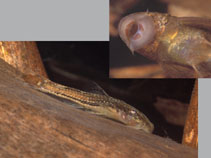| Family: |
Loricariidae (Armored catfishes), subfamily: Hypoptopomatinae |
| Max. size: |
4 cm SL (male/unsexed); 3.1 cm SL (female) |
| Environment: |
demersal; freshwater |
| Distribution: |
South America: southeastern Brazil. |
| Diagnosis: |
|
| Biology: |
Inhabits streams with rocky and sandy bottom, mostly in shallows and backwaters up to 30 cm deep, with slow water flow (0.5-10 cm/sec). Forages mostly during the day with some night activity also recorded. Grazes on microscopic algae, mostly diatoms and green algae growing on rocks and submersed vegetation; occasionally takes chironomid and simuliid larvae. Before grazing on a patch with dense sediment, it makes wiggling head-down movements to dislodge sediment. When scrapping algae off the substrate, it makes vigorous mouth movements, and moves by jerky movements probably related to its mouth making alternate grazing and attaching to the substrate. Grazing leaves characteristic, parallel and elongated marks on the substrate. Density may reach about 0.09 fish.m-2 in stream stretches shaded by forest canopy and 0.15 fish.m-2 in sunned stretches (Ref. 26630). |
| IUCN Red List Status: |
Not Evaluated (N.E.) Ref. (130435)
|
| Threat to humans: |
harmless |
Source and more info: www.fishbase.org. For personal, classroom, and other internal use only. Not for publication.

